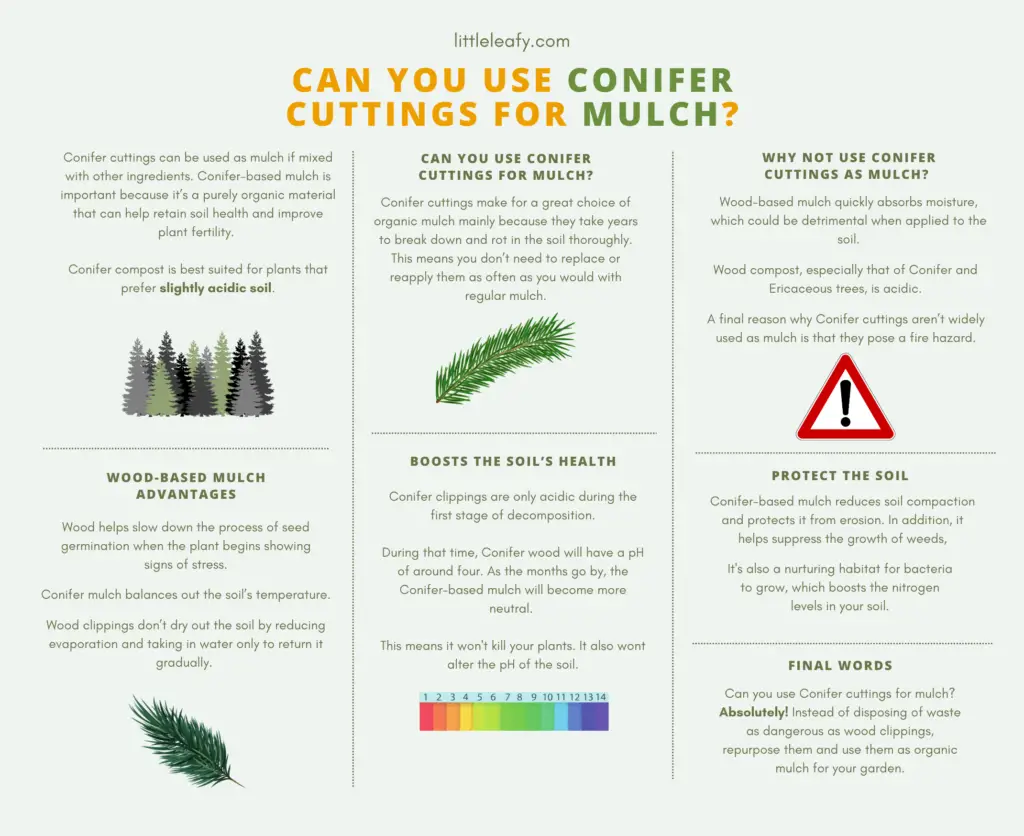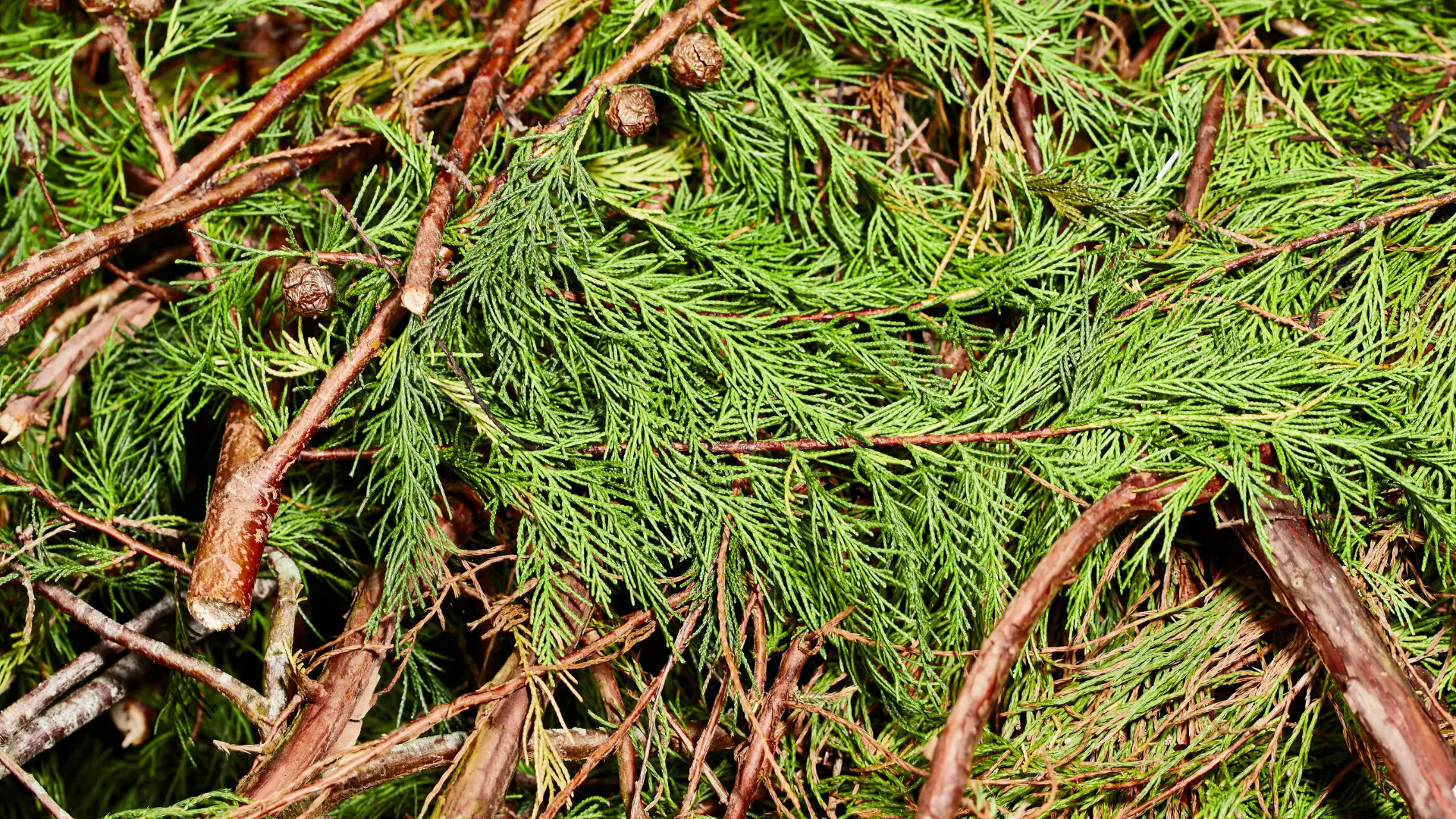Reading Time: 4 minutes 🍃
Any gardener should know that yard waste, such as grass clippings and wood cuttings, could be repurposed instead of hastily thrown away. One of the many uses you should consider is to make mulch out of your garden’s refuse.
Conifer cuttings can be used as mulch if mixed with other ingredients. Conifer-based mulch is important because it’s a purely organic material that can help retain soil health and improve plant fertility. Conifer compost is best suited for plants that prefer slightly acidic soil.
This quick guide will answer a few pressing questions, including whether you can use Conifer cuttings for mulch and why you should.
So, can you use conifer cuttings for mulch?

Can You Use Conifer Cuttings for Mulch?
Trees that are classified as Conifers are those which grow cones. Pine, Spruce, Fir, Juniper, and more are all considered Conifer trees.
Economically speaking, Conifers are widely used for woodworking purposes. Most furniture, buildings, and paper are made from Conifer wood.
Not only that, but the uses of Conifer cuttings also extend to garden care. Their main purpose in the yard is to be used as mulch for the soil.
Conifer cuttings make for a great choice of organic mulch mainly because they take years to break down and rot in the soil thoroughly. This means you don’t need to replace or reapply them as often as you would with regular mulch.
Due to Conifer clippings’ extensive decomposition process, they’re used for decorative purposes rather than in mulch composts. Because certain plants require regular care, it becomes difficult to check the soil when bits of wood are poking out everywhere.
That said, due to the high acid content of Conifer compost, it usually works best with plants that thrive in acidic soil. Strawberries, blueberries, and hydrangeas are a few examples of garden plants that’ll highly appreciate a Conifer-based mulch.
Why Not Use Conifer Cuttings as Mulch?
For multiple reasons, many garden owners turn away from using wood clippings as mulch. Many people find that wood-based mulch quickly absorbs moisture, which could be detrimental when applied to the soil.
Since most plants enjoy well-drained or at least moist soil, wood mulch can affect the moisture levels, causing the soil to dry out too fast. This is also why you don’t add Conifer compost to dry soil.
One of the other arguments gardeners make is that wood compost, especially that of Conifer and Ericaceous trees, is acidic. In other words, if it’s not used correctly, mulch from these trees will upset the pH levels of the soil, causing the plants to wither.
A final reason why Conifer cuttings aren’t widely used as mulch is that they pose a fire hazard. When mixing wood with soil, there’s always a safety concern, particularly if you live in a hot or arid climate.
Did you know, though, that any kind of organic mulch is susceptible to starting a fire? So, whether made from wood or not, you still need to be careful when adding mulch.
Why Do Conifer Cuttings Make Good Compost?
Considering the concerns about Conifer cuttings we mentioned above, you may be wondering: why should I use Conifer compost in the first place?
There are many benefits you stand to gain from using Conifer-based mulch. This section goes through them one by one, so you can decide if recycling your wood clippings is a good choice or not.
Wood-Based Mulch Advantages
With Conifer compost, you still enjoy the essential functions of an organic-based mulch. For instance, wood helps slow down the process of seed germination when the plant begins showing signs of stress.
Additionally, Conifer mulch balances out the soil’s temperatures. Contrary to popular belief, wood doesn’t absorb all the soil’s moisture. Conifer cuttings work in a way that keeps the soil evenly moist.
Wood clippings don’t dry out the soil by reducing evaporation and taking in water only to return it gradually. The one downside to remember is that wood-based mulch isn’t rich in nutrients, unlike leafy mulch.
Boosts the Soil’s Health
While it’s widely assumed that Conifer mulch is acidic and thus harmful to plants, studies show otherwise. Conifer clippings are only acidic during the first stage of decomposition.
During that time, Conifer wood will have a pH of around four. As the months go by, the Conifer-based mulch will become more neutral. Its pH levels become alkaline-like (6.5 or 7) once it fully decomposes into the soil.
How does this help your plant’s health? For starters, it doesn’t kill it! It also doesn’t alter the pH of the soil since the mulch is typically applied above the surface, no more than five inches deep.
Protect the Soil
The other great thing about Conifer-based mulch is that it reduces soil compaction and protects it from erosion. In addition, it helps suppress the growth of weeds, especially when you apply the mulch during the early spring.
Because wood clippings are usually large and coarse, they take around four to five years to decompose fully. As a result, Conifer mulch is a nurturing habitat for bacteria to grow, which boosts the nitrogen levels in your soil.
It may not be a significant increase, but any soil greatly benefits from nitrogen, no matter how little. By mixing in an equal amount of grass clippings with your Conifer cuttings, you double the number of nutrients in the mulch.
Summary
Can you use Conifer cuttings for mulch? Absolutely! Instead of disposing of waste as dangerous as wood clippings, repurpose them and use them as organic mulch for your garden.
Despite the concerns surrounding wood-based mulch, you’ll find that they’re mostly based on myth. Conifer cuttings can protect your soil from erosion and boost its health by maintaining the soil’s conditions.
Consider adding grass clippings to your heap of Conifer compost for added nutrients!
Sources
- https://www.rhs.org.uk/soil-composts-mulches/woody-waste-using-as-mulch

- https://www.gardeningknowhow.com/garden-how-to/mulch/using-pine-bark-mulch.htm

- https://homeguides.sfgate.com/shredded-pine-bad-gardens-91236.html


